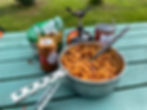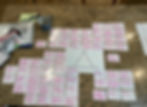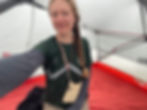PhD cycle tour gear list: everything I brought on my 12-week fieldwork ride across England
- Veronica
- Jul 28
- 6 min read
Updated: Jul 30
Disclaimer: this is a personal blog post and not an official output of my PhD fieldwork
Earlier this month, I finished my 2000-mile fieldwork cycle tour across England. For those 12 weeks, my bike was my home. Everything I needed, I carried with me.
Here's what I brought:

For the whole trip, I was hoping to do a proper photoshoot of the gear I had brought with me, but I didn't find the right opportunity until I made it back to Exeter! So, on a hot July afternoon a few days after getting home, I cycled to the local park, laid out all my gear in the midday sun, and took some photos with my drone.
A few notes before we dive into the gear list:
If you're just starting out with bikepacking/cycle touring, I want to reassure you that you don't need all of this gear to go for your first overnighter! All you need is a bike you feel comfortable riding, some camping equipment, and a way to attach said camping equipment onto your bike!
A lot of the gear I took with me was lent to me by friends and family – thank you so much! I'm not sure what I would have done without this kindness!
Because the drone shot above was taken after I'd finished my trip, it doesn't have any of the food I brought with me on my ride, which did take up a considerable amount of space. I can do a separate post about the food I ate on the trip, if people are interested. For the most part, my breakfasts consisted of cereal and dried milk, lunch was whatever I could find en route, and dinner was a dehydrated camping meal from TentMeals or something else easy to prepare on my camping stove. Plus, there were lots of snacks along the way!
I really wanted to measure the weight of my bike and gear, but never found an opportunity to do so! All I can say is, it was not a light-weight setup.

Bike setup and gear:
Most of my gear was stuffed into my four pannier bags, with the rest fitted into my handelbar bag and frame bag. The two larger pannier bags on the back of my bike were very organised, and I always knew where I could find what I was looking for – one bag held all of the things I needed to set up camp in the evening, while the other held my research folder, drone, tripod, cooking equipment, and day clothes. The two smaller bags on the front, however, where chaos for most of the ride and I never really knew where anything was. The frame bag ended up being very handy for storing camping meals, snacks, and my external battery, which I used to charge my phone while riding (with my phone attached to my handlebars using my Quad Lock mount).
Bike (Genesis Tour De Fer 10, fitted with butterfly handlebars)
Helmet (Giant)
4x panniers (Ortlieb)
6.5 L handlebar bag, plus padded insert (Ortlieb)
Custom frame bag (Offcut Gear)
Small saddle bag
Cycling computer and stem mount (Garmin Edge 830)
Front and rear lights (Cateye, front light attached to front fork using Restrap mount)
Phone handlebar mount (Quad Lock)
Hydration pack (Camelbak)
High-vis and reflective vest (Proviz)
Sunglasses (Decathalon)
D-lock and cable
2x water bottles
Chain oil and rag
Hand pump
3x bungee cords of different lengths
3x dry bags – 8L, 13L, and 20L (Sea to Summit)

Bike repair kit:
Luckily, I only ran into one proper mechanical issue, and I was within a few kilometres of a bike shop, so it was sorted quickly. As a result, I didn't need to use most of the things I brought with me in my repair kit.
2x spare inner tubes
Patch kit
2x chain quick link
Rope
Tyre levers
T-block multitool
Crankbrothers multi-tool
Small roll of duct tape
At the campsite:
I was very lucky to borrow some lightweight camping gear from David and Esther from Act Big Live Small, including a three-person tent. It might seem silly to have taken such a large tent with me on a solo trip, but I knew I could potentially be spending a lot of time stuck in my tent, so I wanted to be comfortable. This tent was also fun because you can pitch it without the rainfly, and sleep under the stars (which I did a number of times on the Exeter to London stretch of my ride).
Tent (REI Quarter Dome)
Sleeping pad (Sea to Summit Etherlight XT)
Three-season sleeping bag (Marmot)
Inflatable pillow (Sea to Summit)
Sleeping bag liner
Flip flops
Earplugs (Loop)
Sheep stuffed animal
Hot water bottle (for first four weeks)
Concentrated laundry detergent (Sea to Summit)
Folding chair (Helinox)
Cable lock alarm (MINDER)
2x quick dry towel (large & small)
Washing line
Head torch
Sketchpad and watercolour paints

Clothing:
I basically wore the same outfit every day I was on my bike, alternating between padded leggings and padded shorts (the latter which I typically wore underneath my hiking trousers). I washed the leggings/shorts every night after wearing them, which meant one could be drying while I was wearing the other pair (this method worked well when it was dry out, less well when it was rainy). I had the opportunity to use a washing machine a handful of times along my route, but otherwise just washed clothes at campsites or hotels and put them out to dry in the sun. On the bike, all of my clothes were stored in two separate dry bags to keep things easy (and dry!). In the smallest dry bag, I stored all of my sleeping clothes, and in the medium-sized dry bag, I stored everything else. This made it quick to find the clothes I needed when I arrived at a campsite in the evening.
Sun shirt (Rab)
Crop sports bra (Korsa)
Padded leggings
Padded shorts
Hiking trousers
Lightweight neck gaiter (Skida)
Rain coat
Sleeping clothes (t-shirt, long-sleeve shirt, trousers, cosy sweater, thick socks)
Fleece
Spare cycling clothes (shirt, sports shorts)
Jumpsuit
Spare off-bike clothes (leggings, t-shirt)
2x hats (beanie, cycling hat)
Fingerless wool gloves
Underwear (x4) and socks (x3)
Swimsuit

Toiletries:
Just the basics, stored in a folding toiletries bag from Decathalon.
Toothbrush and toothpaste
Retainer
SPF moisturiser
Sunscreen
Soap, shampoo, and conditioner
Lipbalm
Contraceptive pill
Mini deodrant (Wild)
Cooking:
I used the same simple camping setup that Brett and I have used while backpacking and it worked a treat.
Camping stove (OEX Etna Mini Stove)
Pot and grip
Fuel canister and lighter
Folding knife
Mini chopping board
Ultralight long handle spork (Sea to Summit)
Cleaning cloth and washing up liquid
2x canvas tote bags (for food shopping)

Electronics and photography gear:
Setting off, I was a little nervous it would be a challenge to keep all of my electronics charged, so I was pleasantly surprised that many of the campsites I stayed at had places to charge electronics (even if it was just a random plug in the bathroom). I would typically plug in one of my external batteries to be charged overnight while I slept, and then use that to charge my phone during the day. Everything else I would charge whenever I wasn't camping.
Phone
Kindle
Wall plug and various charging cables
Headphones
2x external batteries
Camera (Fujifilm)
Extra camera batteries and SD cards
Drone (DJI Flip), plus remote and charger
Folding travel tripod (SIRUI)
Phone mount for tripod

Research gear:
Due to space constraints, I had to keep my research materials as streamlined as possible. I was able to print out additional participant information sheets and consent forms at a handful of locations along my route, which meant I didn't have to carry too many at any one time. For my interviews, I used dry erase playing cards paired with coloured whiteboard markers as reusable post-it notes that the participant could interact with. And since it was such a dry spring, I only used my wellies a few times!
Lapel microphone
Waterproof field journal and notebook
Handheld microphone
Participant information sheets and consent forms
Dry erase playing cards
Whiteboard markers
Laminated project documents
Project flyers, stickers, and pins
Ankle wellies
Pen, pencil, highlighter
"University of Exeter" and "Social Scientist" pins

Safety:
A lot of thought went into safety precautions for my trip, which were outlined in an extensive risk assessment. There were, unsurprisingly, a whole host of safety concerns, so I did a lot of training and preparation to minimise risks where possible. Although you can't see it in most photos from the trip, I kept my whistle and travel neck pouch tucked beneath my shirt at all times, even while sleeping. The Garmin inReach was sending my location to my family every hour while I was riding and, luckily, I only needed to use my emergency phone once, when I accidentally left my normal phone in a participant's car! Even better, I only needed to crack out the first aid kit once, to grab painkillers after I injured my back in the last week of my trip.
Whistle
Travel neck pouch (with cash, photo ID, laminated documents with insurance details and emergency contact details)
First aid kit
Emergency phone (kept switched off)
SOS Satellite Communicator (Garmin inReach)
Glow stick
Energy chews (Clif Blocks)
Tiger balm
Ibuprofen
SPF lipbalm

Things I brought, that I didn't end up using much:
The following items, I brought with me, but didn't end up using much (or at all, in some cases).
Poop kit
Face towel
Camping mug
Red dress for self portraits
Another pair of socks
Hiking umbrella
Folding keyboard
Waterproof cover for phone
